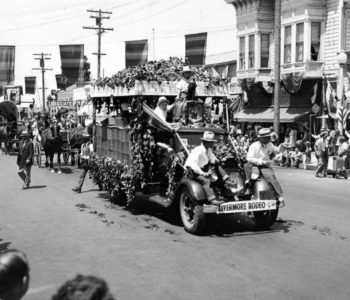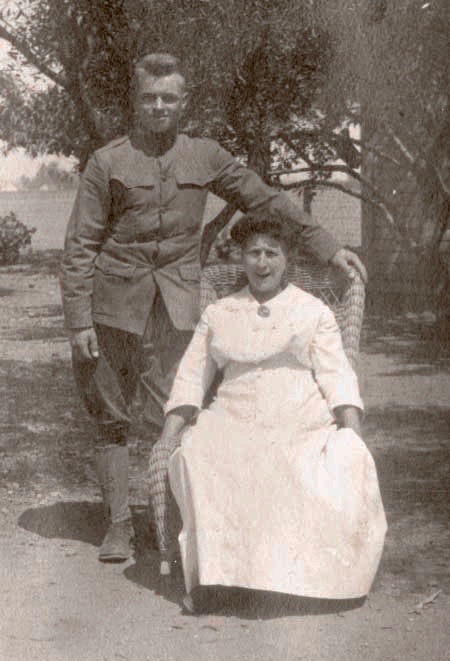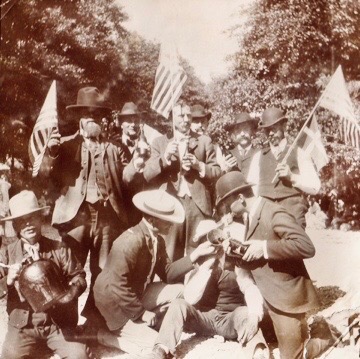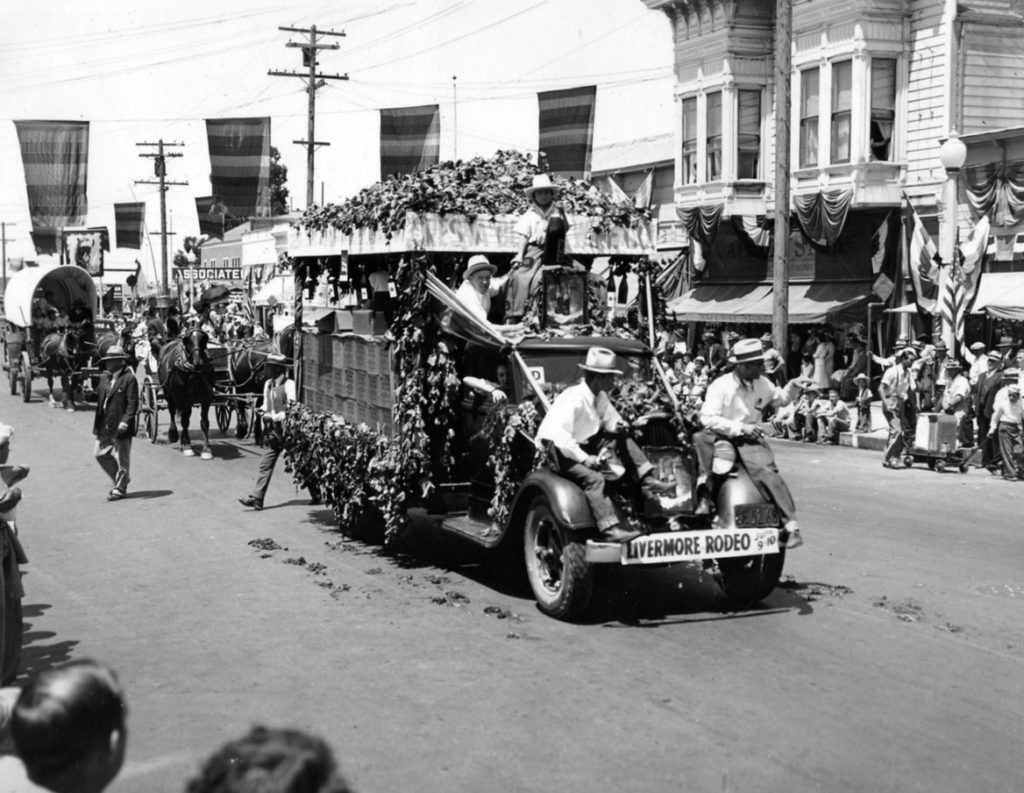 Livermore Valley
Livermore Valley
100 Years Since the Volstead Act in the Livermore…
By Laina Carter of McGrail Vineyards & Winery
This Friday, January 17th, 2020, at precisely 12AM, marks 100 years since the Volstead Act was put into effect, making it illegal for the American people to produce, sell, or transport alcoholic beverages. Coincidentally, this date has been named “National Bootlegger’s Day,” but primarily due to the fact that it is the birthday of famous bootlegger Al Capone and Meryl Kerkhoff, the son of another prolific prohibition era bootlegger.₇ The 18th Amendment to the United States Constitution was ratified in 1919 and the alcoholic beverage industry, in the Livermore Valley and across the nation, appeared to be headed toward total eradication. This week we will celebrate what is now National Bootlegger’s Day in the Livermore Valley because our beloved industry ceased to die, despite efforts made to eliminate it a century ago.

The Volstead Act: A Brief History
In the year 1917, Andrew Volstead, Chairman of the House Judiciary Committee and after whom the act was named, along with members of the Anti-Saloon League and the Women’s Christian Temperance Union, joined together to champion the bill behind prohibition.₁₁ The bill was vetoed by President Woodrow Wilson, but Congress overruled his veto, and the National Prohibition Act was ultimately passed in 1919.₁₀
Why Prohibition?

At a glance, prohibition’s primary driving factor was its appearance of being a solution to a few of the problems America was facing at the time. Alcoholism was rampant in the United States in the early 1900’s. It is estimated that people were consuming a whopping ten to fourteen times what the average American drinks today, in terms of volume of pure alcohol. Even more astounding is the fact that any person over the age of 15 years could legally drink alcohol.₉ Advocates of the temperance movement believed the resources being used to make alcohol would be of better use elsewhere. With World War I taking place from 1914 until 1918, some prohibition supporters argued it would be advantageous to take the wheat utilized in beer production and use it to make bread to feed soldiers instead.₁ Supporters of child labor laws also became proponents of prohibition, as the Prohibition Party was the first political party in American history to denounce the employment of children in industrial fields.₆ With so many clear, concise arguments for prohibition, there were bound to be a few that were not as agreeable.
In addition to the obvious benefits of prohibition, some supporters had blatantly outlandish beliefs and downright prejudiced principles that drove their support of banning alcoholic beverages. Some dry advocates believed the origin of all crime in the United States was alcohol consumption. A few American towns were so persuaded by this, they went as far as to close down and sell their jails just a moment before prohibition was put into effect. Others were brainwashed into believing frequent alcohol drinkers had the ability to spontaneously combust due to a high blood alcohol content. A certain temperance writer, who, absolutely absurdly, was considered “scientific authority” at the time, wrote that even a sniff of alcohol could lead to three generations worth of birth defects.₂ We now know these statements to be so brazenly false, they are laughable, but, amazingly, there were actual Americans who believed them to be true. Those who disapproved of the permeation of European immigrants through the American population in the early 1900’s found themselves in favor of prohibition, as several European customs involved the production and consumption of alcoholic beverages. The Irish brought their whiskey, the Catholics brought their wine, and the Germans brought their beer to the United States, but xenophobic Americans were not fans of such traditions, or, rather, they were not fans of immigrants.₁ Other groups known for being prejudiced were champions of the temperance movement as well. The Ku Klux Klan were known supporters of prohibition. KKK chapters across the nation were revived to support and enforce temperance, which became one of the group’s main purposes at the end of the 1910’s. As was to be expected, opponents of prohibition, especially bootleggers, were often victims of violent attacks at the hands of the KKK.₃

By the time prohibition had taken effect, a large population of the American people, even members of Congress, who voted in favor of prohibition, admitted to feeling tricked into doing so, because they were led to believe, or had naively assumed, only hard liquors would be banned.₉ The 18th Amendment implicitly stated intoxicating liquors would be banned with its passage, but it fundamentally failed to define the term “intoxicating liquors.” Meanwhile, the Volstead Act defined intoxicating liquors as any beverage that contained just above “one half of one percent alcohol.”₁₁ Even with some beers at the time containing an insignificant 2.75 percent alcohol, an amount so tiny it would be virtually unmarketable in today’s America, such beverages were to be banned.₁₂
Did Prohibition Work?
“The Noble Experiment,” also known as National Prohibition, saw a specific type of success. According to a study done by economists at Boston University and M.I.T. in the 1990’s, alcohol consumption in the United States declined by 70 percent in the early 1920’s.₁ Even though support for prohibition had dwindled significantly by the end of the 1920’s and 74 percent of voters were in support of the repeal of the 18th Amendment by 1932, alcohol consumption at the time of repeal was still down 30 percent from what it had been prior to the Volstead Act taking effect.₄ If the only thing America was trying to do by banning alcohol was decrease alcohol consumption, prohibition worked.
If you take a step back and look at prohibition in its entirety, it was a massive failure.
Crime didn’t just take a break during prohibition. Crime flourished during prohibition and it flourished because of prohibition. Smuggling alcohol into the U.S. over the Canadian border was a frequent and lucrative business for organized criminals throughout prohibition. It wasn’t uncommon for alcohol smugglers to fall victim to murder or having their boats hijacked while moving alcohol into the U.S. Alcohol smuggled across the border was even more desirable than that made illegally in the United States, because it was more likely to be coming from a legitimate distillery and not from someone’s bathtub, decreasing the odds of it being tainted and probably ensuring a higher quality of taste. Speakeasies, or secret, illegal bars, were everywhere around the country and encouraged dangerous activities, like binge drinking;₄ New York City was estimated to have an insurmountable 30,000 of them in the 1920’s.₉ The Ku Klux Klan was torturing and killing bootleggers and alcohol drinkers during prohibition, enforcing their ideal of it being a sin to drink alcohol.₁₂
Public officials and officers of the law became increasingly corrupt as prohibition progressed. The term “blind pig” was coined in reference to police officers who would turn a blind eye to the operation of speakeasies upon payment from speakeasy owners. Many public officials engaged in the illegal activities themselves. The Speaker of the House of Representatives was the owner and operator of an illegal distillery during prohibition.₂ The nation’s respect for public officers and members of law enforcement quickly waned as incidents of corruption continued to come to light. Between the years 1921 and 1923, in New York City, the conviction rate was one to every 260 arrests, as prosecutors seriously struggled to obtain convictions, due to lack of trustworthiness from arresting officers.₄
Regrettably, it is estimated that more than 10,000 people died during prohibition as a result of drinking alcohol that had either been accidentally tainted by bootleggers or had been purposely poisoned by industrial alcohol companies, per the request of the federal government.₁ Some alcohol was still being produced in the United States during prohibition, but solely for industrial purposes. The federal government realized this industrial alcohol could be manipulated to create alcoholic beverages. The Prohibition Bureau required these alcohol-producing companies to contaminate the alcohol with poisonous substances to make it unfit for drinking.₄ Folks still drunk the industrial alcohol, causing many to be stricken blind, become extremely ill, or die.₁ Even illegal distillers were accidentally poisoning people with their hooch. Some alcoholic beverage recipes called for the use of lead coils, iodine, and even embalming fluids, all of which are toxic to humans.₄
In addition to the multiple obvious, aforementioned reasons as to why prohibition failed, the country also lost out on what would have been a great deal of money in taxes paid on alcoholic beverages and the country’s taste for genuinely good quality wine and spirits was lost because of prohibition.₉
As we know now, prohibition was a complete disaster. Surprisingly enough, there are still chapters of the Anti-Saloon League that exist in the United States, as well as over 100 counties across the states that are completely dry.₂ When wineries today are asked to ship wine to other states, they are often jumping through hoops to obtain the correct permits, while some states don’t allow wine to be shipped to them at all. It is amazing that one hundred years later we are still feeling the effects of prohibition on the alcoholic beverage industry.
Prohibition’s Impact On Grape Growers In California and the Livermore Valley
One of the most interesting facets of the Livermore Valley is its claim to being one of the first winegrowing regions in California. With that being said, it is both fascinating and valuable to take a closer look at just how this American Viticulture Area was impacted by one of the most controversial laws in American history–prohibition. As someone who belongs to the sixth generation of a long-time Livermore family, whose family owned vineyards in the Livermore Valley in the late 1800’s, and who currently works in the wine industry in the valley, this history is captivating to me.

With the first systematized plantings of grapes in the Livermore Valley taking place in the late 1870’s, the valley already had a rich history in wine growing by the time prohibition reared its ugly head. The first men to establish both vineyards and wineries in the Livermore Valley had done so just after having esteemed the 1884 vintage as being of supreme quality. Just a few years after having first planted vineyards in the valley, two Livermore Valley wineries were awarded prestigious awards at the 1889 Paris Exposition. Cresta Blanca Winery was awarded the Grand Prize and the Mont Rouge Winery was awarded gold for their Livermore Valley wines. Vineyards began popping up around the valley at a remarkable rate, with over 156 of them pervading more than 5,500 acres by the year 1893. Sadly, many were devastated by the sweeping of Phylloxera through the Livermore Valley in the late 1890’s and the acreage of vineyards had been diminished to just 2,500 by 1911. Subsequent to the cessation of the spread of disease throughout vineyards across the valley, a glimmer of hope appeared for the once-again prosperous Livermore Valley wine industry. The demand for wine and the quality of wine began to experience significant growth in the valley, which, in turn prompted an expansion in vineyards planted, increasing to nearly 4,000 acres at around 1918. With the news of the passing of prohibition, acres of vineyards planted in the Livermore Valley returned to its plummet, with approximately 3,000 acres planted at the beginning of 1920 and another downturn to a measly 1,500 acres planted just shortly after.₈

Even before the 18th Amendment was passed, the future looked grim for the industry. In June of 1918, the Livermore ECHO, a local, weekly newspaper at the time, published an article discussing a couple saloons in nearby Stockton, California, that were planning to close their doors in preparation for the November election, during which two prohibition measures would be voted on. In the months following the publication of this article and leading up to the November election, the Livermore Herald published several articles with menacing headlines such as, “Reports Unfavorable for the Wine Industry,” and “Final Vintage Now In Progress.” Though the first World War did not end until November 11th, 1918, the future of the alcoholic beverage industry, and more specifically the wine industry, was of utmost importance for the people of the Livermore Valley and reports on the war were often superseded by reports on prohibition in local publications.₈
In the months leading up to January 17th, 1920, there was a mad rush among producers of alcoholic beverages to either sell their inventory of alcoholic drinks or dispose of it.₈ Although American people were prohibited from making and selling commercial alcoholic beverages, it was not illegal to drink alcoholic beverages, and many Americans resorted to constructing cellars in their homes to store their wine and spirits.₁ There was almost a year between the passage of the 18th Amendment in January of 1919 and the Volstead Act taking effect, but sales of “beer, wine or other intoxicating malt or vinous liquor,” was forbade after June 30th, 1919.₁₂ In a three month period following the ratification of the 18th Amendment, an estimated 141 million wine bottles were sold in the United States.₉ Not only was wine sold in unprecedented volumes, wine that was once sold for 35 cents per gallon was now being sold for as much as $1.50 per gallon!₈ Smart business men were getting rich by buying gallons upon gallons of wine and marking up prices as the people of America were scurrying to buy whatever alcoholic beverages might remain before sales became illegal.₉
Following the Volstead Act taking effect, the Livermore Valley’s winemakers, vintners, and vineyard workers left to look for work elsewhere or found work in fields they might not have been skilled in. Vineyard equipment was either sold or disposed of. On January 17th, 1920, the Livermore Herald published a headline, “PROHIBITION ENDS GREAT INDUSTRY – WINERIES OF VALLEY DISPOSE OF STOCK AND CLOSE THEIR DOORS.” Three days later, on January 20th, the Herald published another headline: “CRESTA BLANCA CLEANED OUT… C.H. Wente, C.L. Crellin, A.C. McLeod, Garatti Bros., and several other valley men, made no wine this year. … The wine industry is doomed!”₈ Indeed, the state of the industry appeared bleak for many Livermore Valley winegrowers.

Hard times call for innovation in the wine industry, and for those who possessed this quality and were able to use it to their advantage, the difficult times could be forded through. While vineyard owners and wineries were no longer permitted to produce wine to sell to consumers and distributors, they were not prohibited from producing and selling sacramental wine to the Catholic Church. Livermore Valley’s Concannon Winery had established a market for sacramental wine with the Catholic Church many years prior to prohibition and they were able to use this relationship to remain afloat through prohibition.₈ Several California wineries, including Beaulieu Winery, Beringer Winery, and previously mentioned Concannon Winery, were able to remain open and in production through prohibition, under the stipulation that their singular purpose for remaining active as a winery was to produce sacramental wine to be used during Catholic service. Even still, prohibition officers were wary of these wineries, shutting some down for exceeding the production of one million gallons of wine in just two years.₉ Like it was legal to drink wine at home, it was also legal to make up to 200 gallons of wine per year at home. Other grape growers found business through innovation by creating and selling “wine bricks” through prohibition. Wine bricks were blocks containing all that one needed to make wine at home, except for one or two simple ingredients, like water or soda. This was huge for California winegrowers, as wine bricks became wildly popular on the east coast and could be shipped there in exchange for a pretty penny.₉
With the majority of Americans voting against prohibition in 1932, change was on its way for California winegrowers.₄ Franklin Delano Roosevelt was elected President of the United States on November 8th, 1932, and one year and twenty seven days later, the 18th Amendment was repealed with the passage of the 21st Amendment.₅ On Repeal Day, December 5th, 1933, FDR declared, “what America needs now is a drink!”₂ On November 30th, 1933, good news came to California, as an announcement from the State Equalization Board said sales licenses for alcoholic beverages would soon be distributed. On December 7th, the Southern Alameda County News published an article stating “activity among the wineries of the Livermore Valley has gained greater impetus. All plants are being worked to capacity as orders for the fine wine for which this valley is famous for come in.” By December 21st, the Livermore Herald had full page ads for Livermore wineries.₈ The Livermore Valley had restored its vigor, though there was still much to regain in terms of vineyards, winemakers, production equipment, and vineyard workers.
Today, the Livermore Valley is home to more than 50 wineries and continues to grow. It is humbling to know the history of what the wine producers in the valley have experienced over the years and to get to live and work in their footsteps.
Bootleggers In the Livermore Valley
Did you know there were bootleggers in the Livermore Valley? Me neither. While I knew it was possible for the Livermore Valley to have had bootleggers, some history is just so cool you can’t imagine it happening where you live.
To give some background on “bootleggers,” the term was first coined in the 1880’s when Midwestern traders would hide flasks in their boots when making a trade with the native people. The term “bootlegger” eventually evolved to signify a person who made, transported, or sold alcoholic beverages after Congress passed the 18th Amendment and before the passage of the 21st Amendment, becoming a permanent part of American vocabulary.₇

An article published in the Livermore Herald in 1978 discusses an institution called the Yosemite Club, located on Second Street in Livermore, which was a bootleg establishment during prohibition. The carpenter who constructed the building, Everett “Gab” Garbini, recalls a twenty foot hole underneath the floor of the building, where empty bottles were thrown when finished. During prohibition, the hole served a different purpose, allowing full bottles, or “evidence” at the time, to be thrown and destroyed when federal prohibition officers came in.₈ While the Yosemite Club no longer exists, the building still stands, though it has undergone renovations. A Vietnamese restaurant currently exists at the Yosemite Club’s former address and I’m unsure if the twenty-foot hole still exists under the floor. One thing we do know is Livermore has a little piece of bootlegging history and I think that’s pretty fascinating!
At McGrail Vineyards, we are so proud to be a part of the continued history of the Livermore Valley! We hope this has given you some insight into and appreciation for how far our hidden gem of a wine region has come.
Cheers and Happy National Bootlegger’s Day!
Sources Cited
- Andrews, Evan. “10 Things You Should Know About Prohibition.” History, A&E Television Networks, LLC., 22 February 2019, https://www.history.com/news/10-things-you-should-know-about-prohibition.
- Hanson, David J. “For Fun Prohibition Trivia, This is the “real McCoy.”” Alcohol Problems and Solutions, D.J. Hanson, 16 January 2019. https://www.alcoholproblemsandsolutions.org/trivia-about-prohibition-fun-facts-you-didnt-know/.
- Hanson, David J. “KKK (Ku Klux Klan), Alcohol, & Prohibition: The KKK Supported Prohibition.” Alcohol Problems and Solutions, D.J. Hanson, 16 January 2019. https://www.alcoholproblemsandsolutions.org/the-kkk-supported-prohibition/.
- Hanson, David J. “The Noble Experiment of Prohibition in the U.S.” Alcohol Problems and Solutions, D.J. Hanson, 16 January 2019. https://www.alcoholproblemsandsolutions.org/noble-experiment-of-prohibition-in-the-u-s/.
- Levy, Michael and The Editors of Encyclopaedia Britannica. “United States election of 1932.” Encyclopaedia Brittannica, Encyclopaedia Brittannica, Inc. 9 November 2019, https://www.britannica.com/event/United-States-presidential-election-of-1932.
- Michael Schuman, “History of child labor in the United States—part 2: the reform movement,” Monthly Labor Review, U.S. Bureau of Labor Statistics, January 2017, https://doi.org/10.21916/mlr.2017.2.
- “National Bootlegger’s Day.” National Day Calendar, National Day Calendar, 16 January 2019. https://nationaldaycalendar.com/national-bootleggers-day/.
- Newton, Janet. Stories of the Vineyards and Wineries of the Livermore Valley. Livermore: The Livermore Printing House. Janet Newton, 1987. Print.
- Puckette, Madeline. “What Really Happened During Prohibition.” Wine Folly, Wine Folly, Inc., 16 September 2015, https://winefolly.com/update/prohibition-facts/.
- The Editors of Encyclopaedia Britannica. “Volstead Act.” Encyclopaedia Brittannica, Encyclopaedia Brittannica, Inc. 21 November 2019, https://www.britannica.com/topic/Volstead-Act.
- “The Senate Overrides the President’s Veto of the Volstead Act.” United States Senate, Senate.gov, 16 January 2019, https://www.senate.gov/artandhistory/history/minute/Volstead_Act.htm.
- Whiteside, George W. “BEER WITH AN ALCOHOLIC CONTENT OF 2.75 PER CENT. IS NOT AN INTOXICATING BEVERAGE.” New York State Journal of Medicine, Vol. XIX, No. 1, 1919, pp. 240. Print.